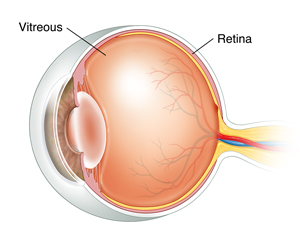Diabetic Retinopathy: Having a Vitrectomy
You have diabetic retinopathy. This is an eye condition that happens when diabetes harms blood vessels in the back of the eye. It can cause cloudy eyesight and other problems. A vitrectomy surgery may help you see more clearly.
What is vitrectomy?
The gel (vitreous humor) that fills the eye is normally clear. But with diabetic retinopathy, this gel can be clouded with blood or debris. During vitrectomy, the eye care provider takes out the cloudy gel. It's replaced with fluid, silicone oil, or gas. The retina may also be treated if there's scar tissue. This can help you see more clearly. If you still have problems seeing after your surgery, you may need more surgery. A vitrectomy may make it possible to do other procedures to help restore eyesight, such as laser treatments for diabetic retinopathy, retinal detachment, and treatment of macular holes.

Getting ready for the surgery
-
Tell your healthcare provider about all medicines you take. This includes over-the-counter and prescription medicines, vitamins, herbs, and supplements. It also includes aspirin, ibuprofen, ginkgo, and warfarin or other blood thinners.
-
Before surgery, you'll meet with a healthcare provider (anesthesiologist) who gives medicine to control pain. You’ll talk about the type of pain medicine and sedation (anesthesia) you'll have during the surgery.
-
You'll be asked to sign a consent form. This explains the surgery to be performed and the risks involved. By signing the form, you agree to have the surgery. Have all of your questions answered before signing the form. You will also be asked to sign a consent form for anesthesia to be given.
During the surgery
During the surgery, the healthcare provider makes small cuts (incisions) in the white of the eye (the sclera). Tiny tools are put through the cuts. The vitreous is removed. It's replaced with something that holds the retina in place. This may be saltwater (saline) solution, silicone oil, or a gas bubble. The surgery may take a few hours.
After the surgery
-
An adult family member or friend must drive you home after the surgery. Wear dark sunglasses on the way home.
-
Before leaving, you’ll be told how to protect and care for your eye. You'll need to use eye drops for a few days. This is to ease swelling and prevent infection. Don’t rub, touch, or bump your eye.
-
You may need to wear an eye patch for a few days or weeks.
-
The surgeon may tell you to lie face down for a while after the surgery. This helps the retina heal.
-
Ask your healthcare provider how long to wait before you can lift things, exercise, or swim. Ask when you can drive and go back to work.
Before you leave, know what number to call if you have questions or problems when you get home. You should also have written discharge instructions. If you have low vision, ask the provider to print the information in a larger size you can read.
Controlling pain
Vitrectomy may cause some pain. You’ll be given medicine to control this pain. If pain continues or gets worse, tell your healthcare provider.
Possible risks and complications
Risks and possible complications include:
-
Swollen or droopy eyelid
-
Double or blurry vision
-
Detached retina
-
Bloody white of the eye (sclera)
-
Watery or red discharge
-
Pain
-
Cloudy eye lens (cataract)
-
Eyesight doesn't get better
When to call your healthcare provider
After you go home, call your healthcare provider or seek medical care right away if you have:
-
More pain, redness, or discharge that may mean you have an eye infection
-
Problems seeing after the eye patch is removed
Online Medical Reviewer:
Chris Southard RN
Online Medical Reviewer:
Rajadurai Samnishanth Researcher
Online Medical Reviewer:
Rita Sather RN
Date Last Reviewed:
4/1/2024
© 2000-2024 The StayWell Company, LLC. All rights reserved. This information is not intended as a substitute for professional medical care. Always follow your healthcare professional's instructions.